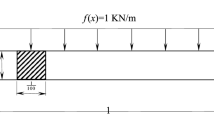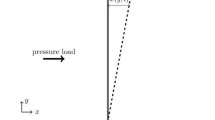Abstract
In stochastic structural mechanics, the treatment of uncertainty is often the main objective of numerical simulations to estimate the responses of a system or physical phenomenon. These predictions can form the basis for decision making, and therefore, a relevant issue to be studied is how reliable they are. Uncertainties, in general, are assessed under two aspects: from the available statistical information and considering the mathematical model that represents the problem numerically. The model identifies a set of relationships based on principles, conservation laws, and metrics of physical magnitude. For the stochastic bending problem of elastic and stationary beams, it is possible to associate randomness to the properties of the material, geometry, and loads on the structure. Thus, the estimates of the responses will be present in the field of stresses and deformations. In the present work, the variational formulation of the stochastic problem of the linear elliptical contour value with random coefficients is studied in light of the stochastic version of the Lax–Milgram lemma. The propagation and uncertainty quantification are investigated based on the recent numerical methodology of asymptotic complexity λ-Neumann–Monte Carlo. The results of the numerical simulation are obtained for the stochastic bending beam problem based on the Levinson–Bickford theory. The theory of high-order elastic bending has the advantage of meeting the condition of zero shears on the lateral surfaces of the beam. Numerical results are presented related to the accuracy, convergence, estimators of statistical moments, error estimate, and the processing time of the approximate solution for the high-order beam.











Similar content being viewed by others
Data Availability Statement
Some or all data, models, or code that support the findings of this study are available from the corresponding author upon reasonable request.
References
Ghanem, R.G., Spanos, P.D.: Stochastic Finite Elements: A Spectral Approach. Springer, New York (1991)
Babuska, I., Tempone, R., Zouraris, G.E.: Solving elliptic boundary value problems with uncertainty coefficients by the Finite Element method: the stochastic formulation. Comput. Methods Appl. Mech. Eng. 194(12–16), 1251–1294 (2005). https://doi.org/10.1016/j.cma.2004.02.026
Sullivan, T.J.: Introduction to Uncertainty Quantification. Springer, Switzerland (2015)
Arnold, L.: Stochastic Differential Equations: Theory and Applications. Wiley Interscience, New York (1973)
Rao, M.M., Swift, R.J.: Probability Theory with Applications, Mathematics and Its Applications, vol. 582. Springer, New York (2006)
Melchers, R.E., Beck, A.T.: Structural Reliability Analysis and Prediction, 3rd edn. Wiley, New York (2018)
Brenner, S.C., Scott, L.R.: The Mathematical Theory of Finite Element Methods. Springer, New York (1994)
Shinozuka, M., Astill, J.: Random eigenvalue problems in structural mechanics. Am. Inst. Aeronaut. Astronaut. J. 10(4), 456–462 (1972). https://doi.org/10.2514/3.50119
Shinozuka, M., Leone, E.: A probabilistic model for spatial distribution of material properties. Eng. Fract. Mech. 8, 217–227 (1976). https://doi.org/10.1016/0013-7944(76)90087-4
Adomian, G., Malakian, K.: Inversion of stochastic partial differential operators: the linear case. J. Math. Anal. Appl. 77, 309–327 (1980). https://doi.org/10.1016/0022-247X(80)90244-9
Shinozuka, M.: Structural response variability. J. Eng. Mech., ASCE 113(6), 825–842 (1987). https://doi.org/10.1061/(ASCE)0733-9399(1987)113:6(825)
Ávila, C.R.S.J., Beck, A.T., Rosa, E.D.: Solution of the stochastic beam bending problem by Galerkin method and the Askey-Wiener scheme. Latin Am. J. Solids Struct. 6(1), 51–72 (2009)
Yamazaki, F., Shinozuka, M., Dasgupta, G.: Neumann expansion for stochastic finite element analysis. J. Eng. Mech., ASCE 114(8), 1335–1354 (1988). https://doi.org/10.1061/(ASCE)0733-9399(1988)114:8(1335)
Araújo, J.M., Awruch, A.M.: On stochastic finite elements for structural analysis. Comput. Struct. 52(3), 461–469 (1994). https://doi.org/10.1016/0045-7949(94)90231-3
Chakraborty, S., Sarkar, S.K.: Analysis of a curved beam on uncertain elastic foundation. Finite Elem. Anal. Des. 36(1), 73–82 (2000). https://doi.org/10.1016/S0168-874X(00)00009-3
Chakraborty, S., Bhattacharyya, B.: An efficient 3D stochastic finite element method. Int. J. Solids Struct. 39(9), 2465–2475 (2002). https://doi.org/10.1016/S0020-7683(02)00080-X
Ávila, C.R.S.J., Beck, A.T.: A Fast convergence parameter for Monte Carlo–Neumann solution of linear stochastic systems. J. Risk Uncertain. Eng. Syst., Part B: Mech. Eng. 1, 1–9 (2015). https://doi.org/10.1115/1.4029741
Ávila, C.R.S.J., Beck, A.T.: New method for efficient Monte Carlo–Neumann solution of linear stochastic systems. Probab. Eng. Mech. 40, 90–96 (2016). https://doi.org/10.1016/j.probengmech.2015.02.006
Levinson, M., Stephens, N.G.: A Second order beam theory. J. Sound Vib. 67(3), 293–305 (1979). https://doi.org/10.1016/0022-460X(79)90537-6
Bickford, W.B.: A consistent higher order beam theory. Dev Theoret. Appl. Mech. 11, 137–150 (1982)
Heyliger, P.R., Reddy, J.N.: A higher order beam finite element for bending and vibration problems. J. Sound Vib. 126(2), 309–326 (1988). https://doi.org/10.1016/0022-460X(88)90244-1
Karama, M., Afaq, K.S., Mistou, S.: Mechanical behavior of laminated composite beam by the new multi-layered laminated composite structures model with transverse shear stress continuity. Int. J. Solids Struct. 40, 1525–1546 (2003). https://doi.org/10.1016/S0020-7683(02)00647-9
Shi, G., Voyiadjis, G.: A sixth-order theory of shear deformable beams with variational consistent boundary conditions. J. Appl. Mech. 78, 1019 (2011). https://doi.org/10.1115/1.4002594
Karttunen, A., von Hertzen, R.: Variational formulation of the static Levinson beam theory. Mech. Res. Commun. 66, 15–19 (2015). https://doi.org/10.1016/j.mechrescom.2015.03.006
Reddy, J.N., Wang, C.M., Lim, G.T., Ng, K.H.: Bending solutions of Levinson beams and plates in terms of the classical theories. Int. J. Solids Struct. 328, 4701–4720 (2001). https://doi.org/10.1016/S0020-7683(00)00298-5
Papargyri-Beskou, S., Tsepoura, K.G., Polyzos, D., Beskos, D.E.: Bending and stability analysis of gradient elastic beams. Int. J. Solids Struct. 40(2), 385–400 (2003). https://doi.org/10.1016/S0020-7683(02)00522-X
Reddy, J.N.: Nonlocal nonlinear formulations for bending of classical and shear deformation theories of beams and plates. Int. J. Eng. Sci. 48(11), 1507–1518 (2010). https://doi.org/10.1016/j.ijengsci.2010.09.020
Stefanou, G.: The stochastic finite element method: Past, present and future. Comput. Methods Appl. Mech. Eng. 198, 1031–1051 (2000). https://doi.org/10.1016/j.cma.2008.11.007
Xiu, D., Shen, J.: Efficient stochastic Galerkin methods for random diffusion equations. J. Comput. Phys. 228, 266–281 (2009). https://doi.org/10.1016/j.jcp.2008.09.008
Grigoriu, M.: Stochastic Calculus Applications in Science and Engineering, p. 784. Springer, New York (2002)
Gittelson, C.J.: Adaptive Galerkin methods for parametric and stochastic operator equations. Ph.D. Thesis, ETH Zurich, No. 19533 (2011)
Author information
Authors and Affiliations
Corresponding author
Additional information
Publisher's Note
Springer Nature remains neutral with regard to jurisdictional claims in published maps and institutional affiliations.
Rights and permissions
About this article
Cite this article
Squarcio, R.M.F., da Silva, C.R.Á. Uncertainty quantification via λ-Neumann methodology of the stochastic bending problem of the Levinson–Bickford beam. Acta Mech 233, 3467–3480 (2022). https://doi.org/10.1007/s00707-022-03266-8
Received:
Revised:
Accepted:
Published:
Issue Date:
DOI: https://doi.org/10.1007/s00707-022-03266-8




